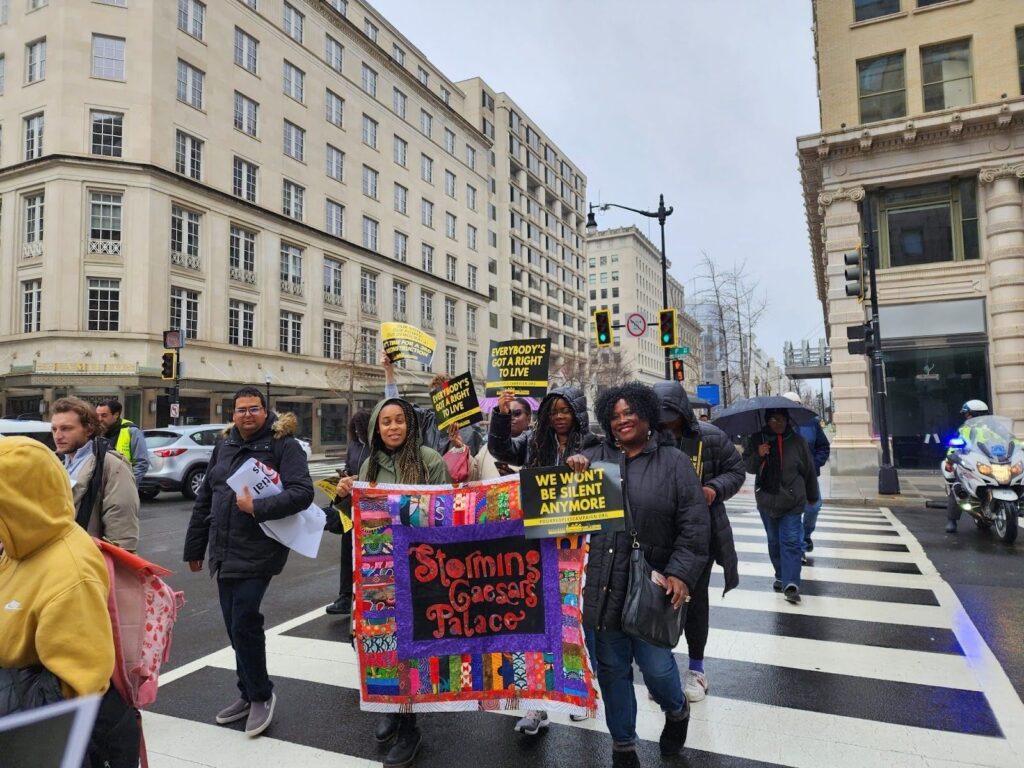A growing digital divide in D.C. became one of several deep-rooted issues the COVID-19 pandemic exacerbated during the past year. To increase access to internet connectivity, digital devices, and the proficiency to use those technologies, city officials are planning to pour an excess of federal funds into the District’s Digital Inclusion Initiative, called Tech Together. Most of the money will be used to buy devices for residents.
Over the next few weeks, D.C. councilmembers will have final debate and make revisions for next year’s city budget.
Mayor Muriel Bowser plans to spend $26.9 million on Tech Together. The goal is to coordinate government agencies, corporations, and local nonprofits to provide better access to devices, broadband internet, and digital training in neighborhoods grappling with inadequate technological infrastructure. That investment would be a dramatic spike from only $387,000 provided last year. The Office of the Chief Technology Officer (“OCTO”), which operates the city’s digital inclusion efforts, launched Tech Together last summer after combining teams from previous digital inclusion efforts.
During an online event held July 15, Chief Technology Officer Lindsey Parker said Tech Together’s proposed budget would be divided between four action areas: $300,000 for broadband infrastructure, $24 million devices and tech support, $1.5 million for digital literacy training, and $4 million for digital services within the District government. OCTO wrote to Street Sense, explaining each of those four Tech Together programs. The broadband infrastructure action area includes connecting residents and businesses to “high-quality, high speed internet.” The largest $24 million bucket for devices “will prioritize seniors, returning citizens, children aging out of foster care, SNAP/TANF households, homeless, temporary housing, and low-income residents.”
The Tech Together program focuses on adults, while other programs in the D.C. government focus on school-age children. “Simply providing internet and a device is not enough to close the digital divide,” OCTO wrote. “[We would be] standing up a community tech support center that families and residents can call into for device troubleshooting.”
The mayor’s proposal recently passed through committee mark-up hearings in the D.C. Council, with the Committee on Government Operations and Facilities reviewing OCTO’s funding. The committee – chaired by At-Large Councilmember Robert White – kept OCTO’s budget mostly intact, preserving $154.7 million of the nearly $156.4 million Bowser had proposed. The committee’s recommendations have been considered along with all other committees’ input and will be revised by D.C. Council during multiple rounds of considerations before a final vote on Aug. 3.
Local residents, advocacy groups, and nonprofit organizations say the digital divide issues facing low-income households during the past year have created barriers to employment and education that have continued to worsen inequity across the city.

Juanita Beltran, who lives in Ward 8, said her neighborhood is riddled with unstable cellular service and “very poor” local internet service with slow speeds, unlike the higher quality of broadband that she’s noticed in Northwest. She said her two children, who have attended school remotely during the pandemic, struggled participating in class because their computers would disconnect from their at-home Wi-Fi and their phones would occasionally freeze if they tried using them as a “hotspot” to relay the data connection.
Beltran, who can’t afford to pay for internet issues to be fixed, said she has used funding from the Emergency Broadband Benefit — a federal program that subsidizes home internet service for low-income families — during the past month after her internet company tried raising her bill from $37 to $58.
“The internet service here is terrible, and of course the internet companies that keep raising your bill, they want to raise your bill after a year,” Beltran said. “I was like, ‘OK, one, I don’t mind paying if I actually have good service,’ and with the kids doing online college courses, I was like ‘They need their laptops working, and they have to reboot or restart if the internet phases out.’”
Beltran said she encountered additional connectivity issues while trying to apply for jobs earlier during the pandemic when she was unemployed, refreshing pages or restarting her computer midway through an application because of internet problems. She said additional funding from the city would provide a “big boost” to families in Southeast struggling to find employment and keep their children engaged in remote learning.
“These low-income families, it’s hard for them to keep doing their homework or stay up to date with their homework because they don’t have any laptops at home,” she said. “They don’t have any iPads or whatever fancy gadget that helps them do their homework.”
Anne-Marie Bairstow, director of the nonprofit workforce development organization Skyland Workforce Center, said technology has served as one of the biggest challenges for participants in the program who do not have the devices and internet needed for online job interviews and applications. She said these issues date back to before the pandemic, but the online work environment has highlighted the difficulties facing workers with little-to-no digital experience.
“I just have seen a lot of people kind of get flummoxed by the whole virtual job fair, virtual interview, and then also just the whole process when everything’s online of searching for jobs, it’s really kind of demoralizing,” she said. Bairstow explained that employers use software to sort through applications and job seekers don’t receive constructive feedback or encouragement from employers sending automated rejection messages or no response at all. “ “I think that this is probably the biggest reason why there are people who aren’t getting jobs.”
Bairstow said digital literacy training – teaching residents technological skills so they’re well equipped to use computers and navigate the internet – will be the most crucial budget line item to fund during the next fiscal year. “The training, there’s just no substitute for that,” she said. “And that’s not just offering some classes, but there should be places that people can go and get one-on-one help with whatever it is that they need.”
Devices can be purchased or donated and broadband internet can be provided at public libraries but training and empowerment is priceless, according to Bairstow.
“I hope that people realize that when everything moved online, a lot of people got left behind and that even since so many more things are online now, it’s really important for people to have that connectivity and be able to use that,” Bairstow said.
Grace Hu, founder of the local advocacy group Digital Equity in D.C. Education, said the District needs to create a “multi-year comprehensive tech plan” to devise a strategy for combating the digital divide. She said city officials have failed to provide evidence backed by data indicating that they’ve identified all the different digital needs facing families across D.C. While the city’s $26.9 million investment is a “good starting point,” Hu said she can’t be sure whether the cash will be properly allocated without the release of data or a citywide survey that quantifies the needs created by the digital divide.
D.C. produced a 2015 report — State of the Digital Divide — that identified many of these connectivity challenges. However, that report used an outdated standard for “high-speed” internet. Broadband infrastructure investments from private internet companies were counted if they provided 4 Mbps speed for any price. That speed is insufficient to stream uninterrupted video to one device, let alone multiple devices simultaneously between several people using the same connection. Many families opt to use expensive wireless data because their homes aren’t even connected to a wire that could deliver the modern, federal standard for broadband speed: 25 Mbps. With a good connection to a nearby cell tower, all major wireless carriers deliver faster speeds than 25 MBps, which is enough to stream HD video on one -three devices at the same time.
With nearly 90% of Tech Together’s budget directed to devices, Hu said she didn’t see enough information about how the city will accompany devices with effective digital literacy training and expanded broadband access. “There hasn’t been a citywide digital survey, and so without that, I can’t say if that investment is going to be enough,” Hu said. “I can’t say they’re allocating it in the right way because I haven’t seen the data about where it’s needed.”
New York City released its “Internet Master Plan” in early 2020, offering universal broadband internet service as a $2.1 billion investment. Sacramento, Chattanooga, Houston and Philadelphia are among other city governments that have taken steps to foster greater digital inclusion. Those cities often adopt to directly subsidize installation of faster wired connections just as they would upgrade sidewalks for disabled residents. Chattanooga and other municipalities chose to directly offer municipal broadband services to increase access to affordable, high speed internet.
Have you had trouble with affordable internet service and connectivity in the District? Email [email protected].








